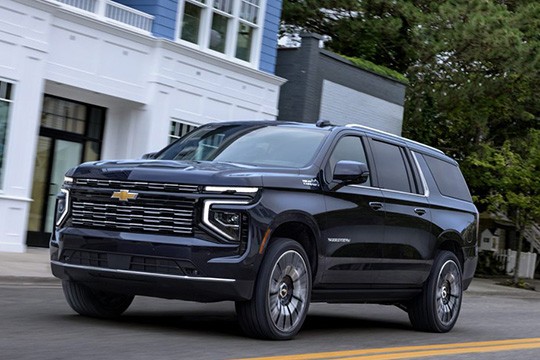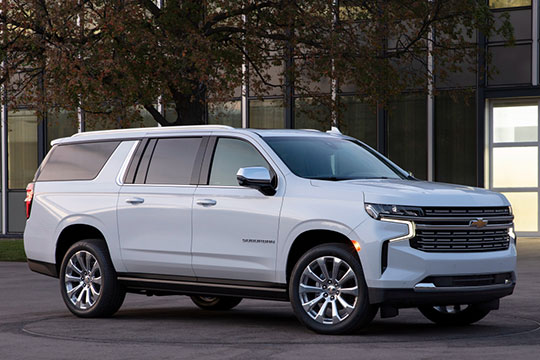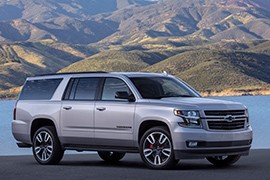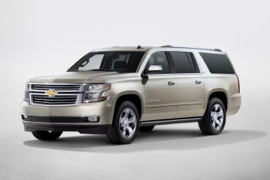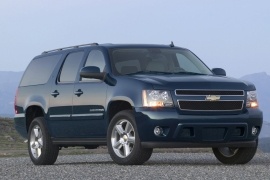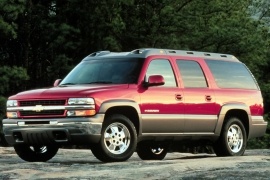CHEVROLET Suburban Models/Series Timeline, Specifications & Photos
First production year: 1999
Engines: Diesel, Gasoline, Natural gas
Body style: SUV (Sports Utility Vehicle)
The Suburban is the oldest nameplate in automotive history, continuously used by Chevrolet since 1935 and passing through twelve generations until 2021.
In 2023, the twelfth generation of the Suburban went through a mid-life cycle refresh along with its shorter sibling, the Tahoe. Both vehicles had led the full-size SUV market in the US for more than 45 years, but Chevrolet didn’t want to slow down the pace. It drastically improved the Suburban in all areas, making the big SUV look like a different generation. However, it stood on the same chassis as the non-facelifted version. Furthermore, the technology package inside the cabin and the engine lineup were upgraded for the 2025 model year.
At the front, the 2025 Chevy Suburban had redesigned daytime running lights with an angular look pointed toward the car’s center. The big grille with horizontal slats received chromed accents that adorned it, and the bow-tie badge took center stage. Lower, on the bumper, Chevrolet added another cooling area and, underneath it, a small lip spoiler. The high-country trim level of the vehicle featured piano-black accents between the hood and the main grille. Chevy also considered improving the truck’s aerodynamics and added vents that flanked the front fascia to create an air curtain around the wheels.
From its profile, the Suburban kept its main characteristics of a long SUV, with four doors and a long window behind it. The automaker offered the vehicle with standard 18” alloy wheels, and depending on the grade and options, customers could get the Suburban with up to 24” alloys. Like its non-facelifted sibling, the vehicle could get powered running boards that extended to ease ingress and egress. Furthermore, the darkened B-post made the vehicle look even bigger. In addition, the D-pillars were black and created the image of a wrapped-around window area formed by the side rear windows and the one from the tailgate. Finally, at the back, the automaker introduced new taillights that sported a longer lower section and a shorter upper one.
Inside, the Suburban was a place for large families. Its three-row seating allowed up to nine people on board. At the front, customers could notice the new dashboard that sat lower than on the non-facelifted version to provide better front visibility for the driver. For the same reason, the instrument cluster display was reduced by one inch (2.5 cm) but was still large enough at an 11-inch diagonal. Furthermore, Chevrolet installed a 17.7-inch touchscreen for the infotainment system that sported a physical volume knob in its upper left corner.
Another significant improvement for the vehicle was the complex camera system that allowed the owner to see the car’s interior even after they locked it and were away via an app for their smartphone. Accessing the second and the third row of seats was easy, and these provided enough legroom and headroom for everybody. In addition, behind the last row, there was still plenty of storage area in the trunk.
Chevrolet offered the 2025 Suburban with a choice of three engines: two gas-powered V8s and a 3.0-liter inline six turbo-diesel carried over from the Silverado. All versions were paired with a ten-speed automatic transmission that sent the power to the rear wheels or in all corners. The AWD versions of the Suburban also featured a low-range transfer box.
The Chevrolet Suburban was first produced in 1934 and is the longest-running continuous nameplate in production establishing. At the end of 2019, a new chapter in the Suburban story began with the introduction of the 12th generation.
The 2020 Suburban has a longer wheelbase than the previous model and new chassis systems that create greater ride smoothness, particularly on uneven pavement and unpaved surfaces. The new Suburban has the most passenger and cargo space of any SUV in its segment. The new multilink independent rear suspension, new technologies like Rear Pedestrian Alert and HD Surround Vision, new rear-seat media system and the new interior were specifically designed to take advantage of the class-leading space, with a mission to create the ultimate road trip environment.
It is worth mentioning that the vehicles' load floors are significantly lower, providing a more natural seating position and a remarkable gain of 10 inches (254 mm) of third-row legroom, with big increases in cargo space.
As for engines, the optional Duramax 3.0L inline-six turbo-diesel is available on all models except Z71 and develops 277 hp of power with a strong 460 lb-ft of torque, providing some of the highest fuel economy ratings in this segment.
At this time, Chevrolet Suburban is the only one in its segment with a diesel engine.
Chevrolet prepared in 2018 a special package for the eleventh Suburban generation, which brought more power and more performance to one of the most oversized SUVs on the market.
The Suburban was always the less-equipped version of the Tahoe, even if GM built both of them on the same chassis. It shared more parts and features with its spoiled brother but usually didn't get the same engines to play with. The 2018 Suburban RST, or Rally Sport Truck, came to fix that and provided more than just more ponies under the hood.
On the outside, the carmaker deleted all the chromed trims from the grille, door handles, and side step-boards. The carmaker painted them in body color and, if the car was black, it offered an aggressive look. Moreover, its red brake calipers from the 410 mm (16.1") Brembo brakes were a clue that it was more than a customized Suburban.
Inside, the Suburban RST featured three seat rows for seven adult passengers with captain seats in the middle. Its leather-clad interior looked nothing less than a Tahoe. On top of that, Chevrolet included two folding screens mounted on the ceiling for rear-seat entertainment. The dashboard and instrument cluster showed a similar look to the rest of the Suburban range.
On the technical side, the RST featured a 6.2-liter V-8 engine that provided 420 hp, and GM paired it to a standard 10-speed automatic.
The Chevrolet Suburban name was on the market since 1935. There are a lot of car brands that cannot claim a long history like that. In fact, the Suburban name was the oldest name in the automotive industry which was still in production.
The twelfth generation of the Chevrolet Suburban was introduced in September 2013. The body-on-frame architecture was kept, in order to keep the production costs low. The weight was not a problem as long as it could be moved by one of the large V8 engines available on the manufacturer's shelf.
The American design was plain and simple as a shape, but there were some details that were changed. On the front, the dual-headlight system with HID bulbs, projector-beam, and the DRL system was standard. The massive chromed grille hosted the bow-tie Chevrolet logo design in the middle. For the car's construction, some light materials were used. The hood and the liftgate were made out of aluminum to ease-up the vehicle. But it was still a 2.5-ton vehicle (5586 lbs).
Inside, the Suburban was able to be configured with seatings for up to 9 passengers, but options for 8 or 6 were available. The driver had a lot of buttons and controls, more than into a normal vehicle. Apart from the regular ones, it had controls for the retractable sideboards (entering steps) trailer assist, power tilt and telescoping column, and many more. The instrument cluster had six analog dials, including the voltage and the oil pressure.
As for the engines, the 2015 Suburban was made more fuel-efficient due to its cylinder deactivation system, which helped the big SUV run in 4 cylinder mode. The standard transmission was a 6-speed automatic.
The tenth generation of Chevrolet Suburban has kept going as the oldest nameplate in the Chevrolet lineup. Its capability to tow, haul, and transport nine passengers on any kind of road conditions made it a favorite for millions of Americans, and not only. In 2006 it was launched as a 2007 model, with a range of three V8 engines under the hood.
The Suburban was available either as a 1500 or 2500 series (half-ton or three-quarter ton). The half-ton had a 5.3-liter engine with 295 hp and 454 Nm (335 lb-ft) of torque. It was available with either a 2wd or a 4wd system. Bigger variants, with 6.0-liter and 8.1-liter V8s, featured a 4wd configuration as standard. The 8.1-liter was the big hauler, able to pull up to 12.000 pounds (5440 kg). All vehicles had 4-speed automatic transmission fitted as standard.
There were different trim levels as well. The Z71 stands out since it had an off-road package.
Interior options were matching those of a luxury vehicle. Since the Cadillac Escalade was built on the same chassis, some of the features meant for the luxurious American brand were transferred to the family carrier.
In the safety department, Chevrolet installed standard dual-stage airbags. Standard dual-stage front airbags deploy based on crash severity, and a passenger seat safety system can sense the presence of a child riding up front and disable the airbag to prevent injury.
GM introduced the ninth generation of the Suburban in 1999, and it was another proof that people didn't need a minivan to carry eight people inside.
The behemoth-sized SUV was based on the trustworthy GMT830 chassis used for the GMC Silverado/GMC Sierra pickup. It could handle rugged terrain, punishing roads, and pull heavy trailers. It had only two enemies: fuel consumption and winding roads.
The Suburban was the workhorse of the family. It wasn't luxurious or fancy. It was more of a redneck wearing Wranglers and a pair of boots who could go to a five-star resort and ask for a beer in a red cup. At the front, the Suburban featured a dual headlight system with rounded edges and a chromed slat that crossed the front fascia from left to right. It was slightly shorter, narrower, and with a shorter wheelbase than its predecessor. In the back, the Suburban featured a classic tailgate with a flip-up window, good to throw some groceries in the trunk.
Inside, it was available in a few seating configurations, but the standard was with three rows with a couple of seats at the front and three on each of the other two rows. The dashboard looked similar to the one installed in the Chevrolet Silverado, with a tall instrument cluster extended over the center stack. A wide and tall center console separated the front wide bucket seats. All of the other seats could have been folded or removed to increase the trunk.
Under the hood, Chevrolet installed a choice of three engines ranged between 5.3-liters and 8.1-liters paired to a standard four-speed automatic transmission.
